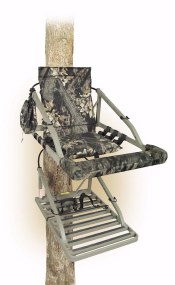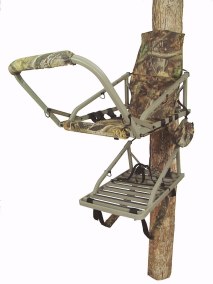| SEASON' S OUTLOOK / WHITETAIL |
The total harvest for last season was 9,143, and as expected was down from the 2000 harvest of 10,859. This decrease (16 percent) was the result of higher than normal winter deer mortality during the relatively severe winter of 2000-01, especially in the northern part of the state, and an attempt to reduce the antlerless harvest in 2001 to begin to offset the effects of this winter mortality. The 2001 harvest included 6,547 bucks and 2,596 does. Archers took 1,577 deer (797 bucks and 780 does); muzzleloader hunters took 2,261 deer (1,631 bucks and 630 does);and firearms hunters took 5,102 deer (4,035 bucks and 1,067 does). The special youth weekend resulted in a total harvest of 203 deer (84 bucks and 119 does). As in past years, the harvest saw many deer taken that exceeded 200 pounds dressed weight, and all 10 counties produced deer of this quality in the 2001 season.
The 2002 season should again provide the opportunity for hunters across the state to encounter trophy-class animals. While it may take another year to fully recover from the additional deer mortality and resulting population decreases due to the winter of 2000-01, the winter of 2001-02 proved to be relatively mild. Combined with the reduced antlerless harvest in 2001, we should see deer numbers rebound for the fall of 2002. NewHampshire's deer season dates will be similar to those of 2001 and should provide hunters with high quality hunting opportunities throughout the fall.
Other deer hunting opportunities available forthe fall of 2002 include a second archery tag, special Unit M antlerless permits and Long Island permits. Be sure to check the 2002-03New Hampshire Hunting Digest for additional season details and check out the opportunities for on-line licensing and permit applications at www.wildlife.state.nh.us.
NEW HAMPSHIRE FISH & GAME DEPARTMENT
DEER HERD STATISTICS
· 2000 Pre-hunt deer population: 75,000 deer· Deer population trend: Increased from early 80s to late 90s and decreased over last couple of years.
· Reason for recent decline: Over harvest of females during last 4 hunting seasons
· Reason for over harvest: Artifact of our management system (either-sex day system)
· 2000 deer season objective: Aimed at reducing the overall female harvest and equitably allocating the allowable harvest between user groups (archery, muzzle, firearms)
· 2000 deer season facts: Reduced female harvest from previous year but still over harvested females in 10 WMUs. Shot 10,859 deer (7,472 males, 3,387 females)
· Management Plan: Calls for statewide increase in the deer herd of approximately 30%
· Adult sex ratio: 1.5 adult females per adult male
· Adult male age classes: Approximately 46% of the adult buck population is 1.5 years old approximately 27% of the adult buck population is 2.5 years old approximately 27% of the adult buck population is 3.5+ years old.
· Winter 2000-01: One of worst winters since 1965 (only 2 winters in the past 20 years were this severe)
· 2002 Deer Season: Biological staff proposed changes to the season – reduced female harvest in an effort to offset some of the losses from this winter
NEWS from CPSC
U.S. Consumer Product Safety Commission
Washington, DC 20207
|
October 30, 2002 Release # 03-027 |
API Recall Hotline: (866) 215-2419
CPSC Consumer Hotline: (800) 638-2772
CPSC Media Contact: Scott Wolfson, (301) 504-0580 Ext. 1189
|
CPSC, API Outdoors Announce Recall of Hunting Treestands
WASHINGTON, D.C. - In cooperation with the U.S. Consumer Product Safety Commission (CPSC), API Outdoors of Tallulah, La., a division of Outland Sports Inc., of Overland Park, Kan., is voluntarily recalling about 9,000 treestands used by hunters. A cable that secures the treestand to the tree can break, posing the risk of falls and serious injuries to hunters.
API Outdoors has received two reports of the treestand's cable breaking, including one person who fell from a tree and suffered leg abrasions.
The recalled treestands have the following brand names and model numbers: API Hi-Point Cable Cat Climbing Treestand, Model #CC501 and API Buckmaster Grand Slam Climbing Treestand, Model #GS3800BM. The treestands have an olive green frame, camo seats and seatbacks with black nylon cinch straps, and a yellow "WARNING" or "DANGER" label that reads in part, "Safety Restraint Must Be Used At All Times." The treestands are manufactured in Tallulah, La.
Retailers and distributors nationwide, including Wal-Mart, sold the Cable Cat treestands through mid-October 2002 for about $180 and Cabelas stores nationwide sold the Buckmaster treestands through mid- October 2002 for about $230.
Consumers should stop using these treestands immediately and call API Outdoors toll-free at (866) 215-2419 anytime to receive a free, replacement chain. For more information, consumers can log on to the company's website at http://www.apioutdoors.com/api_outdoors/recall/index.tpl or http://www.outlandsports.com/api_outdoors/recall/index.tpl.
 |
 |
| Deer Hunt Results, 2002 |
RE: Total registered deer kill by Wildlife Management Unit (WMU)
The deer kill by Wildlife Management Unit (WMU) for the 2002 season is listed below with comparisons to the previous 5 years. This is the actual and final deer kill from registration reports. The statewide total (11,089) was up 21% from 2001 and exceeded the 2000 statewide total by 230 (about 2%). It had been anticipated that the 2002 statewide kill would fall between 2000 and 2001 levels. Many of the more northerly WMUs did exhibit harvests between 2000 and 2001 levels while central and southern WMUs tended to have harvests at or above 2000 levels. A number of factors could have contributed to this somewhat higher than expected harvest, including snow cover during much of the 2002 season and somewhat faster than anticipated herd recovery following the winter of 2000-01 due to much milder than "normal" winter conditions in 2001-02.
Harvest data will now be analyzed in detail to insure that the age-sex structure of the harvest and the physical condition of the deer remain compatible with our desired deer herd management goals and the 2003 hunting seasons on a Wildlife Management Unit basis.
Registered deer kill by Wildlife Management Unit (WMU), 1997-2002:
| WMU | 1997 | 1998 | 1999 | 2000 | 2001 | 2002 |
| A | 595 | 610 | 754 | 723 | 432 | 589 |
| B | 202 | 187 | 238 | 236 | 128 | 147 |
| C1 | 59 | 46 | 50 | 91 | 76 | 81 |
| C2 | 111 | 103 | 106 | 122 | 90 | 128 |
| D | 1,067 | 1,097 | 1,186 | 1,103 | 747 | 957 |
| E | 90 | 73 | 63 | 88 | 60 | 72 |
| F | 75 | 71 | 75 | 100 | 93 | 99 |
| G | 602 | 488 | 588 | 610 | 437 | 563 |
| H1 | 688 | 581 | 582 | 539 | 458 | 612 |
| H2 | 1,113 | 970 | 892 | 880 | 812 | 996 |
| I1 | 367 | 279 | 283 | 265 | 218 | 283 |
| I2 | 401 | 258 | 298 | 272 | 203 | 330 |
| J1 | 582 | 457 | 536 | 478 | 361 | 404 |
| J2 | 2,011 | 1,386 | 1,397 | 1,328 | 1,196 | 1,483 |
| K | 1,129 | 814 | 887 | 927 | 810 | 1,017 |
| L | 1,265 | 1,001 | 1,198 | 1,143 | 1,042 | 1,146 |
| M | 1,444 | 1,364 | 1,570 | 1,954 | 1,980 | 2,212 |
| TOTAL | 11,800 | 9,785 | 10,703 | 10,859 | 9,143 | 11,089 |